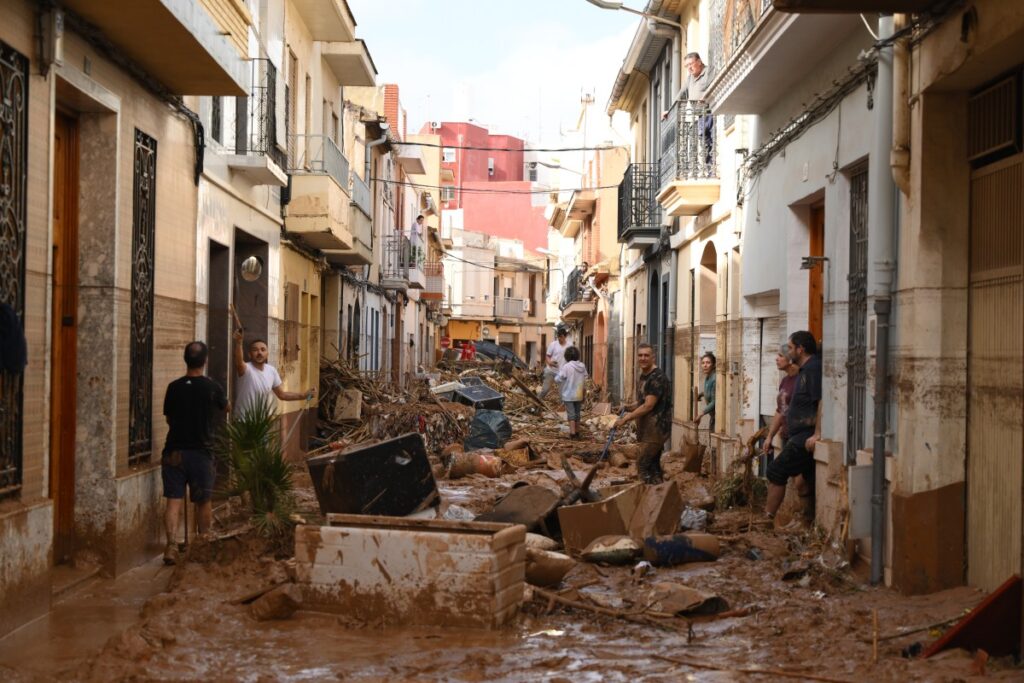Le coste del Mediterraneo sono state testimoni del crescente impatto degli eventi meteorologici estremi. Dall’inondazione del Turia nel 1957, all’attuale tragedia nella stessa regione, il cambiamento climatico è emerso come un fattore chiave nel passaggio da “gocce fredde” a DANA sempre più persistenti. .
Ottobre 1957, città di Valencia: le piogge torrenziali fanno straripare il fiume Turia, allagando la città e causando la morte di oltre 80 persone. Dopo la tragedia – nota nella memoria popolare come riuà – viene lanciato il Plan Sur, un’infrastruttura faraonica per deviare l’alveo del fiume dal centro della città e renderlo in grado di sopportare una maggiore quantità d’acqua.
Settembre 1962, Vallès Occidental, provincia di Barcellona: le piogge eccessive della notte del 25 provocano lo straripamento dei fiumi Llobregat, Ripoll e Besòs, causando devastanti inondazioni e lasciando dietro di sé enormi distruzioni. Il numero delle vittime, stimato tra 600 e 1.000, non è mai stato determinato. La mancanza di pianificazione urbanistica ha messo in evidenza le disuguaglianze, dato che molti dei morti vivevano in baraccopoli in aree a rischio di inondazione come gli argini dei fiumi.
Ottobre 1970: un episodio di “goccia fredda” porta forti piogge nella regione di Murcia e Almería, causando lo straripamento dei fiumi. Si registrarono circa 20 morti. Settembre 1996: piogge torrenziali causano inondazioni ad Almeria, interessando diverse località e causando almeno 8 vittime.
Nel XX secolo, la scuola tedesca di meteorologia coniò il termine “kaltlufttropfen”, tradotto come “goccia d’aria fredda”. Il concetto raggiunse la Spagna e divenne ampiamente noto come “gota fría”, soprattutto per riferirsi a queste piogge torrenziali e persino, in alcune occasioni, alle conseguenti inondazioni. L’esperto José Antonio Fernández Monistrol ha sottolineato che “in spagnolo, l’espressione gota fría è stata distorta e associata a qualsiasi tipo di situazione di precipitazioni abbondanti. Attualmente si usa il termine DANA (Depresión Aislada en Niveles Altos) al posto di gota fría (goccia fredda), che è stato largamente, e talvolta erroneamente, utilizzato”. A partire dagli anni 2000, con l’inizio del secolo, si è diffuso il termine più preciso e tecnico DANA, il cui uso ufficiale e scientifico è ormai ampiamente accettato. Ora, però, il DANA è nell’occhio del ciclone per i reazionari, poiché i negazionisti del cambiamento climatico di ultradestra si rifiutano non solo di usare il termine, ma anche di accettare le prove scientifiche che questo fenomeno diventerà sempre più ricorrente e distruttivo.
Ottobre 2024, area metropolitana di Valencia: nelle prime ore del mattino del 29, l’Agenzia Meteorologica di Stato (AEMET) ha dichiarato un livello di allerta rossa in diverse zone di Valencia. Solo dopo le otto di sera la Protezione Civile, di competenza del governo regionale, ha lanciato un massiccio allarme. A quell’ora, le inondazioni avevano già inondato parte del territorio. Finora, secondo le cifre ufficiali, sono morte più di 200 persone e la ricerca dei dispersi è ancora in corso.
La deviazione dell’alveo del Turia, dopo la realizzazione del Piano Sud con la riuà, impedisce l’inondazione della città di Valencia. Le città interessate dalla struttura idraulica sono quelle a sud della metropoli che, con il boom industriale tra gli anni ’60 e ’80, hanno registrato un aumento della popolazione in cerca di lavoro nei settori manifatturiero e commerciale. La cintura metropolitana meridionale, che ha un profilo operaio e comprende città come Sedaví, Benetússer, Alfafar e Massanassa, è stata la principale vittima della DANA.
Di cosa parliamo quando parliamo di DANA
Una DANA è un fenomeno meteorologico che si verifica quando una massa di aria fredda si stacca dalle principali correnti atmosferiche e rimane “intrappolata” ad alta quota nell’atmosfera. Come spiega graficamente la meteorologa Mar Gómez su El Tiempo, queste tempeste si verificano quando la corrente a getto polare, che normalmente si muove da ovest a est, inizia a ondulare e a formare delle curve, “queste ‘forme’ isolano una parte di questa circolazione come se fosse una piccola sacca al di fuori della circolazione propria dell’atmosfera”, spiega. Ciò provoca instabilità, soprattutto se questa massa d’aria fredda incontra aria più calda e umida a bassa quota, come spesso accade nelle aree vicine al Mediterraneo.
Territorio e stagionalità creano uno scenario esplosivo
Come gli esperti del settore sottolineano da anni, il Mediterraneo occidentale presenta uno dei più alti livelli di rischio di alluvione in Europa. María del Carmen Llasat Botija, docente di Fisica Atmosferica presso il Dipartimento di Fisica Applicata dell’Università di Barcellona, analizza le idiosincrasie del territorio nel rapporto Flood risk in Spain: analysis and solutions for the generation of resilient territories. “Il Mediterraneo è un mare caldo e quasi chiuso, circondato da un’orografia caratterizzata da un notevole rilievo montuoso. Ciò favorisce la ciclogenesi e l’esistenza di una massa d’aria con elevata umidità, instabilità ed energia latente, con il conseguente sviluppo di episodi meteorologici avversi come inondazioni improvvise o forti tempeste di vento”, spiega. “Tutto ciò rende le previsioni meteorologiche, e quindi climatiche, più complicate del solito”, aggiunge Llasat Botija sul fattore erratico che questo comporta.
L’esplosione dei fenomeni idrometeorologici sul territorio è strettamente legata alle condizioni stagionali e alle temperature locali. Nello studio, il professore sottolinea che le piogge convettive – che si verificano quando l’aria calda sale e forma le nuvole – sono caratteristiche dell’estate e dell’inizio dell’autunno, a causa del calore e dell’instabilità atmosferica che prevalgono in questo periodo. Nella regione mediterranea, queste piogge tendono a essere brevi e localizzate in estate. Ma in autunno, quando le acque del mare raggiungono temperature più elevate e l’attività atmosferica aumenta, con la comparsa di fenomeni come i cicloni, l’intensità delle precipitazioni può diventare allarmante. Questa confluenza di fattori può portare a eventi meteorologici catastrofici, causando precipitazioni molto più intense e prolungate, che a loro volta provocano inondazioni e altri gravi problemi per le comunità colpite.
L’emergenza meteo, catalizzatore per il DANA (e per quelli a venire)
L’alterazione del ciclo idrologico globale, come sottolineato dal Gruppo intergovernativo di esperti sul cambiamento climatico, sta modificando la distribuzione e la frequenza delle precipitazioni e delle siccità in tutto il mondo. Questo cambiamento rappresenta una sfida senza precedenti, in quanto centinaia di milioni di persone sono costrette ad adattarsi a condizioni idriche sconosciute fino a pochi decenni fa, senza avere la prospettiva storica necessaria per comprendere questi impatti. A sua volta, l’emergenza climatica sta avendo un effetto negativo sui cicli meteorologici. In questo contesto, il meteorologo dell’AEMET Enrique Fernández Barrera sottolinea in un articolo informativo che il cambiamento climatico può influenzare tre fattori chiave che favoriscono la formazione di una DANA: “l’apporto di umidità, che può essere favorito da un Mediterraneo più caldo o da un maggiore afflusso di aria umida subtropicale; una maggiore instabilità delle correnti a getto; e cambiamenti nei modelli meteorologici su scala più ampia”.
Secondo l’Unione Internazionale per la Conservazione della Natura (IUCN), l’aumento della temperatura nel Mediterraneo sta avanzando del 20% più velocemente rispetto alla media globale, il che sta portando a un aumento dell’evaporazione dell’acqua e, quindi, dell’umidità atmosferica. Secondo l’equazione di Clausius-Clapeyron, per ogni grado di aumento della temperatura, l’aria può contenere il 7% in più di vapore acqueo. Si generano condizioni di maggiore instabilità e le stelle si allineano per la formazione di depressioni isolate di alto livello (ILD). La combinazione di temperature elevate e maggiore carico di umidità aumenta il rischio di gravi inondazioni nella regione, esacerbando la forza di queste tempeste.
L’impatto del cambiamento climatico antropogenico rende il mondo più ostile all’uomo. I discorsi populisti e reazionari tentano di screditare le prove scientifiche; gli avvertimenti sull’aumento della persistenza e dell’intensità dei DANA vengono accolti con un ritorno ai “kaltlufttropfen”, perché, come direbbero alcuni “settori nostalgici”, “i bei tempi andati erano migliori“. Queste tattiche di strumentalizzazione mirano a minare la fiducia del pubblico nelle istituzioni scientifiche, dando priorità al ciclo produttivo e riducendo al minimo la rilevanza dei dati disponibili. Questo indebolimento della credibilità consente ai governi reazionari di evitare di adattare infrastrutture e protocolli a condizioni climatiche sempre più estreme. Senza una gestione della prevenzione e con un intervento successivo che lascia molto a desiderare, nella cintura metropolitana meridionale non c’è ancora la calma dopo la tempesta.



